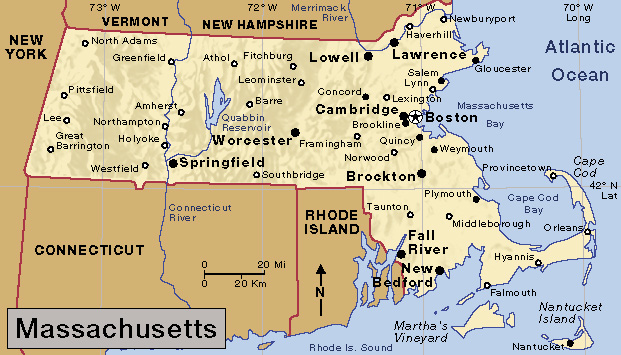Worcester, << WUS tuhr >> (pop. 206,518; met. area pop. 862,111), is a leading New England industrial center and the second largest city of Massachusetts. Worcester lies about 40 miles (64 kilometers) west of Boston, the largest city.

In 1673, settlers from eastern Massachusetts founded the village of Quinsigamond on the site of Worcester. In 1684, King Charles II of England canceled the Massachusetts Bay Colony’s charter. This action so angered the people of Quinsigamond that they renamed their village Worcester. According to tradition, this name honored the Battle of Worcester (1651), in which Charles suffered a great defeat against England’s Parliamentary leader Oliver Cromwell.
Worcester, the county seat of Worcester County, covers 37 square miles (96 square kilometers). Its manufacturing plants produce fabricated metals; printed materials; and chemicals, plastics, and abrasives. Worcester has several medical centers, which employ many of the city’s people. Airlines, railroad freight lines, and passenger trains serve the city.
The College of the Holy Cross, the oldest Roman Catholic college in New England, was founded in Worcester in 1843. The city is also the home of Assumption University, Clark University, Worcester Polytechnic Institute, Worcester State University, and the University of Massachusetts Chan Medical School.
The Worcester Art Museum is known for its art objects from many periods of history. The American Antiquarian Society owns the largest collection of early American publications, including newspapers, sheet music, and children’s books. The EcoTarium includes the Alden Digital Planetarium and a science museum and zoo. Also in Worcester are Mechanics Hall, the site of many cultural events, and the DCU Center, an entertainment and convention center.
Nipmuc Indians lived near the site of Worcester before white people built a village there in 1673. Indians destroyed that settlement and another that was built in 1684. The white people settled Worcester permanently in 1713 and incorporated it as a town in 1722. During the Revolutionary War in America (1775-1783), Worcester became the home of the Massachusetts Spy, a newspaper famous for its support of the colonists.
Manufacturing became important in Worcester after 1828, when the Blackstone Canal linked the town with Narragansett Bay, an arm of the Atlantic Ocean. Worcester received a city charter in 1848. Through the years, the growing number of industrial jobs in Worcester attracted thousands of immigrants.
The city’s population reached 203,486 in 1950. During the last half of the 1900’s, many middle-income families left Worcester and moved to the suburbs. Worcester has a council-manager form of government.
